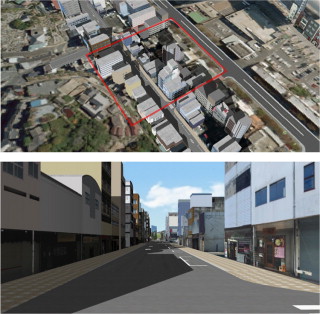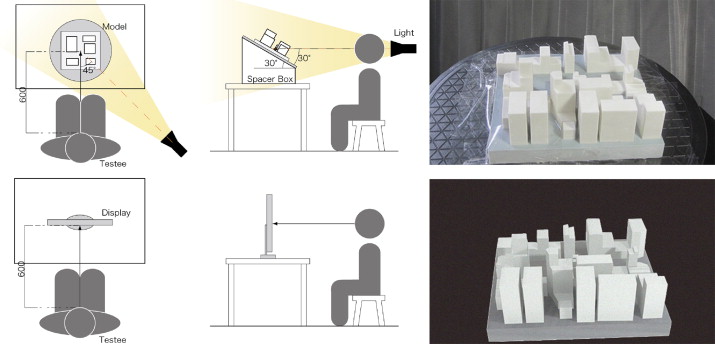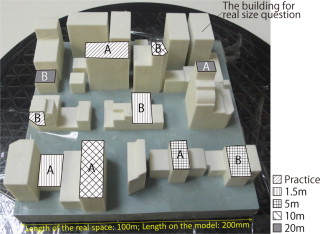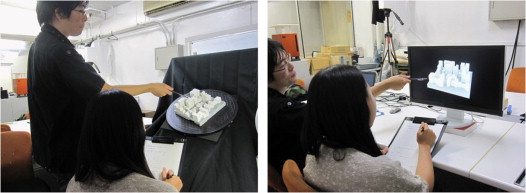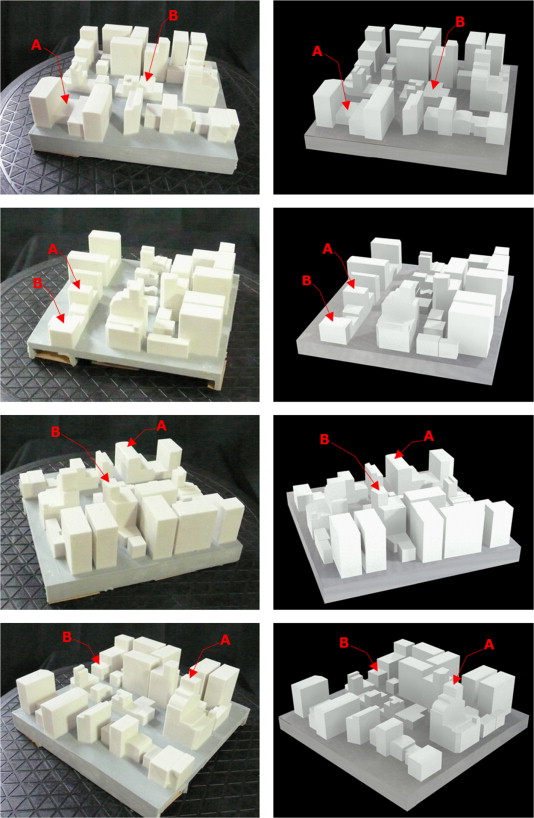Abstract
In the digital age, physical models are still used as major tools in architectural and urban design processes. The reason why designers still use physical models remains unclear. In addition, physical and 3D virtual models have yet to be differentiated. The answers to these questions are too complex to account for in all aspects. Thus, this study only focuses on the differences in spatial understanding between physical and virtual models. In particular, it emphasizes on the perception of scale. For our experiment, respondents were shown a physical model and a virtual model consecutively. A questionnaire was then used to ask the respondents to evaluate these models objectively and to establish which model was more accurate in conveying object size. Compared with the virtual model, the physical model tended to enable quicker and more accurate comparisons of building heights.
Keywords
Spatial understanding ; Scale perception ; Physical model ; Virtual model ; Virtual reality
1. Introduction
In architectural and urban design processes, a consensus building process among various stakeholders, such as project executors, designers, neighborhood residents, users, and the general citizen, is required. Supporting technologies that provide 3D images to study and share future spatial designs have been subjected to research. Despite the digital age, physical models are still used as major tools. Arguing whether a virtual model can substitute for a physical model is an important theme in the field of computer-aided architectural design. In recent years, physical models have been built from 3D virtual models created by 3D computer-aided design (CAD) and building information modeling via a 3D printer or through traditional methods of handcrafting. Numerous studies on tangible user interface and augmented reality (AR) have combined physical and virtual models (Seichter, 2007 ; Kim and Maher, 2008 ; Tokuhara et al ., 2010 ; Wang et al ., 2013 ). The reason why designers still use physical models remains unclear. In addition, physical and 3D virtual models have yet to be differentiated. The answers to these questions are too complex to account for in all aspects. Meanwhile, differences based on a physical-medium model and a virtual-medium model may also be regarded as factors. Thus, this study only focuses on the differences in spatial understanding between physical and virtual models. In particular, it emphasizes on the perception of scale.
1.1. Background
Aside from text and diagrams, 3D visualization media, such as physical and virtual models, are used to confirm space or volume in design and presentation in the architectural and urban planning fields (Dorta and LaLande, 1998 ; Belcher and Brian, 2008 ; Fukuda et al ., 2009 ). Physical and virtual models, such as virtual reality (VR), can display at an arbitrary viewpoint, and thus, they are effective for discussion and examination. A physical model can be observed from any viewpoint and can show the complete image of a depicted city simultaneously. However, difficulties persist if the pedestrian viewpoint and representation limitations caused by the small scale are considered. VR employs a virtual environment (VE), and thus, providing an eye-level viewpoint of pedestrians and drivers, as well as of other people and vehicles, becomes easy. Moreover, VR can dynamically simulate various effects, such as solar radiation. Nevertheless, problems such as intangibility remain. In addition, possible viewpoints are normally limited to a single place. Physical and virtual models are used together in construction sites, as well as in planning or design, because of their distinct characteristics. For example, during the planning and design stage, a physical model is used in the first conceptual expansion phase, and then VR is applied in the convergent design phase (Koga et al., 2008 ).
Combining physical and virtual models has several advantages, including ease of fabrication, user manipulation, low cost, and labor. Meanwhile, differences in physical and virtual models may also be regarded as factors. Spatial reasoning refers to the ability to understand the shape, size, location, and texture of an object or space. People have to use numerous clues and to think carefully to apply spatial reasoning. Moreover, how such clues are used remains unclear because of the complexities caused by distances to an object and observation conditions.
1.2. Previous studies
Siitonen (1995) used and compared a walk-through VR and an endoscope-photographing model method. He verified which technique is better in terms of manipulating objects, lighting, and spatial reasoning ability through visual observations of outcomes as well as interviews with participants. However, the verification results of his study lacked objectivity because they had not been quantified. Focusing on spatial reasoning ability by using medium systems, Witmer and Singer (1998) distributed a questionnaire on control, sensory, distraction, and realism factors that contribute to a sense of presence in VR. Furthermore, Lessiter and Freeman (2001) created a new questionnaire that addressed the sense of physical space, engagement, ecological validity, and negative effects. Spatial reasoning ability was compared with the results from IMAX 2D, IMAX 3D, computer games, and videos. Calibrated principal component analysis was also performed. According to these previous studies, the respondents could still experience the sense of “being there” that was elicited by VR even in another scene, but could hardly do so with a real-medium model.
Schnabel and Kvan (2003) examined the perception and understanding of spatial volumes within immersive and non-immersive VEs through comparisons with representations by using conventional media, such as 2D plans. They employed VEs successfully to study, communicate, and present architectural designs. However, VEs are seldom used in actual creation, form-finding, and collaboration in architecture. Seichter (2007) gauged the differences between two AR interfaces through user evaluation in an urban design studio. Although the targets examined were different, these studies would still be helpful in our study, such as in suggesting research methods.
1.3. Purpose of the study
The present study focuses on differences in spatial reasoning ability observed by using physical and virtual models. In particular, it emphasizes on the perception of scale. We explored issues in accuracy and response time through a series of design experiments. Physical and virtual models were shown to respondents. Then, a questionnaire was used to ask the respondents to evaluate these models objectively and to establish which one was more accurate in conveying object size.
2. Experiment
During the experiment, the same object depicted alternatively by physical and virtual models was shown to the respondents. Three categories were required. The first category was height comparison of relative sizes, the second was the actual size of a building, and the third was the scale of the physical model. The object used in the experiment was a section of a shopping area (square, 100 m) in Buzenda, Shimonoseki City, Yamaguchi Prefecture, Japan, wherein approximately 30 buildings were built with heights ranging from 3 m to 30 m on flat ground. A digital model for VR was created by using Autodesk 3 ds Max® 2010 (Autodesk, Inc., California, USA) and Forum8 UC-win/Road Ver.7 (Forum8, Tokyo, Japan). Figure 1 shows the virtual model created by realistically representing the target city for the experiment. The buildings and the ground used a monochrome texture of white and grey, and thus, judging building floor height or road width would be impossible in the experiment. The physical model was derived from the VR digital data and created by using ZPrinter® 650 (3D Systems, South Carolina, USA), a 3D printer with high accuracy. The scale of the physical model was 1/500.
|
|
|
Figure 1. Virtual model by realistic representation of the target city in the experiment (up: birds-eye view and down: pedestrian view). |
A comparative experiment is required to match the conditions identically, except for the variables. In this study, the proposed physical and virtual models were designed to have the same size and the same façade to define spatial dimension features. To ensure that the models were of the same size, the physical model was created from digital data by using a 3D printer that employs rapid prototyping. If the physical model is traditionally handcrafted and the virtual model is made by CAD, then ensuring that both models will have the same size will be difficult. Therefore, information and communication technology facilitates the preparation in such environmental experiments. VR was performed by stereovision during the preliminary experiment (Olympus Power 3D Media Player with 3D Glasses, Olympus Corporation, Tokyo, Japan). The stereoscopic effect could not be observed because the internal definition for VR in the computer was full size in scale. Therefore, stereovision was not used in this experiment.
During observation, to avoid bias from previous experience in VR operation of the respondents, which could affect the evaluation, the VR camera was set up at an angle of 45° from the ground, thus capturing a fly-through movie (hereinafter "VR movie") that circles around from a birds-eye view. The respondent sat in a natural position 600 mm from the VR display (21 in.) and viewed the display horizontally. A respondent was not expected to look differently at the physical and virtual models. Thus, we attempted to match the two media in terms of size, viewpoint angle, and brightness. In addition, the physical model was fixed on a turntable that could rotate 360° (Figure 2 ).
|
|
|
Figure 2. Position of a respondent and the media (up: physical model and down: virtual model). |
At the beginning of the experiment, the respondents were told that the depicted physical model and the VR movie content were part of a city in Japan. However, they were not informed of its name to reduce the effects of different levels of knowledge or preconceptions related to the location at that time. The physical model and the VR movie were each spanned once before the questions were presented. As each question was answered, the response time was measured by a stopwatch until the end of the final answer.
The first question was on the height comparison of the buildings. Through this question, we explored dimension accuracy and response speed according to differences in building heights and in the models (physical vs. virtual). The questioner presented the physical model and the VR movie consecutively and indicated two buildings with different heights. The respondent was then asked to answer “which building is higher.” Each medium was presented from a still viewpoint to avoid changes in impression caused by pointing the buildings. Four pairs of buildings were presented, and the real height differences were 1.5 m (Building A: 6.5 m, Building B: 5 m), 5 m (A: 15 m, B: 10 m), 10 m (A: 18 m, B: 28 m), and 20 m (A: 30 m, B: 10 m). The respondents viewed the buildings at a 30° angle. Figure 3 shows the pairs of buildings for height comparison. Figure 4 shows the experiment images, and Figure 5 illustrates each viewpoint related to the question on height difference.
|
|
|
Figure 3. The building pairs for height comparison. |
|
|
|
Figure 4. The experiment images (left: physical model and right: virtual model). |
|
|
|
Figure 5. Each viewpoint that requires height difference (up: 1.5 m, upper middle: 5 m, lower middle: 10 m, and down: 20 m). |
The second question was on the actual size of one building and the scale of the physical model. Through this question, we explored the spatial understanding of the respondents. The questioner presented a physical model and a VR movie consecutively and asked the respondent to judge the actual size of one building (Figure 3 , “the building for the question on actual size”). Then, the respondent answered the question “how many millimeters in the physical model” and “how many meters in virtual space.”
3. Results and discussion
Experiments were performed from September 24 (Saturday) to 30 (Friday), 2011 in Room S4-521, Suita Campus, Osaka University, Japan. The respondents were 24 students who belonged to the Graduate School of Engineering in Osaka University. All respondents were in their 20s, among which, 16 were males and 8 were females. To avoid change in impression through the presented sequence of the media, half of the respondents experienced the physical model first, whereas the other half experienced the virtual model first. The experiment was conducted without any conflict.
The statistical analysis presented by using Microsoft Excel 2010 showed that the physical model allowed quicker and more accurate understanding of building height compared with the virtual model. The difference in response time tended to be small for all items if the physical model was first compared with the virtual model. The details of the results are discussed in the succeeding sections.
3.1. The analysis method
A five-point scale was chosen as the response option for the height comparison of the buildings. 1=A is high, 2=A is rather high, 3=same, 4=B is rather high, and 5=B is high. According to the actual height difference, the correct answers were as follows. Number 1 was assigned 1.5, 5, and 20 m; Number 5 was 1 m and 10 m. The mean and variance of the absolute value of the difference in a correct answer and the response in each question were calculated. The response time was set as the average response time for the height comparison of the buildings. To assess the actual size of one building and the scale of the physical model: (i) Ha (mm) was assigned as the height on the physical model, (ii) Hb (m) was the height on the virtual model, and (iii) Hc (m) was the product of building height and scale. H was the correct answer, which was 50 mm for Case (i) and 25 m for Cases (ii) and (iii). The rate of deviation (Eq. (1) ) was defined for each Ha , Hb , Hc , and H ; and the means and variances of these rates were calculated. Exploratory analyses were performed based on the order of the presented media, respondent experience, gender, and the sample.
|
|
( 1) |
3.2. Analysis for all respondents
Table 1 shows the correctness in the responses to the height comparison. Everyone correctly responded to the height differences of the 10 m and 20 m cases in the physical model and the 20 m case in the virtual model. Therefore, tall buildings were evaluated accurately in these cases. The responses elicited from the physical model were more accurate than those from the virtual model in the 1.5 m case within the statistical significance of −5% (5%), and in the 5 m and 10 m cases within the significant difference of −1% (1%).
| Height difference (m) | Medium | Correct | Mean | |Mean−Correct| | Variance |
|---|---|---|---|---|---|
| 1.5 | Physical model | 1 | 1.29⁎ | 0.29 | 0.71 |
| Virtual model | 1 | 1.71 | 0.71 | 1.54 | |
| 5 | Physical model | 1 | 1.13⁎⁎ | 0.13 | 0.19 |
| Virtual model | 1 | 1.92 | 0.92 | 0.99 | |
| 10 | Physical model | 5 | 5.00⁎⁎ | 0 | 0 |
| Virtual model | 5 | 3.96 | 1.04 | 1.29 | |
| 20 | Physical model | 1 | 1.00 | 0 | 0 |
| Virtual model | 1 | 1.00 | 0 | 0 | |
No⁎ : no statistical significance.
⁎. 5%.
⁎⁎. 1%.
Table 2 summarizes some of the results for the response time. The timed responses to the physical model were shorter than those to the virtual model in the 1.5, 5, and 10 m cases within 1%, and the 20 m case within 5%.
| Height difference (m) | Physical model (s) | Virtual model (s) | Physical model–Virtual model (s) |
|---|---|---|---|
| 1.5 | 2.01⁎⁎ | 3.29 | −1.28 |
| 5 | 2.48⁎⁎ | 4.38 | −1.90 |
| 10 | 1.98⁎⁎ | 3.85 | −1.87 |
| 20 | 1.55⁎ | 2.38 | −0.83 |
No⁎ : no statistical significance.
⁎. 5%.
⁎⁎. 1%.
Table 3 indicates the results for the actual size and the scale of the physical model. The physical model exhibited the lowest rate of deviation and the smallest variance among the respondents for the three items in Table 3 , namely, Da , Db , and Dc . By contrast, the variance in scale evaluation exhibited by the sample was large. Moreover, the rate of deviation in the list of physical model×scale was larger than that in the list of virtual model.
| Physical model (Da ) | Virtual model (Db ) | Physical model×scale (Dc ) | |
|---|---|---|---|
| Average rate of deviation | 22.50% | 72.20% | 130.30% |
| Variance | 0.17 | 1.21 | 5.78 |
Consequently, the physical model tended to allow quicker and more accurate comparison of building heights compared with the virtual model. Therefore, a physical model is more intuitive than a virtual model as a spatial understanding model.
3.3. Analysis of presented media order
Response data divided by each height difference were subjected to t -test analysis. As shown in Table 4 ; Table 5 , no significant difference in correctness or response time was found. This result suggested that impression change was not related to whether a physical model or a virtual model was used, as previously discussed in Section 2 . By contrast, the response time difference was small for all items if the physical model was first compared with the virtual model. One reason for this finding was that the participants grasped the complete picture during their VR experience because they had experienced the physical model earlier. In addition, the consequences did not vary by gender.
| Height difference (m) | Medium | Correct | Mean (physical model first) | Mean (virtual model first) | Variance (physical model first) | Variance (virtual model first) |
|---|---|---|---|---|---|---|
| 1.5 | Physical model | 1 | 1.08 | 1.50 | 0.08 | 1.15 |
| Virtual model | 1 | 1.42 | 2.00 | 0.41 | 2.31 | |
| 5 | Physical model | 1 | 1.00 | 1.25 | 0 | 0.33 |
| Virtual model | 1 | 1.83 | 2.00 | 1.31 | 0.62 | |
| 10 | Physical model | 5 | 5.00 | 5.00 | 0 | 0 |
| Virtual model | 5 | 4.25 | 3.67 | 0.85 | 1.44 | |
| 20 | Physical model | 1 | 1.00 | 1.00 | 0 | 0 |
| Virtual model | 1 | 1.00 | 1.00 | 0 | 0 | |
No⁎ : no statistical significance.
| Height difference (m) | First medium presented | Physical model (s) | Virtual model (s) | Physical model–virtual model (s) |
|---|---|---|---|---|
| 1.5 | Physical model | 0.96 | 1.43 | −0.46 |
| Virtual model | 1.68 | 2.94 | −1.26 | |
| 5 | Physical model | 0.72 | 1.35 | −0.64 |
| Virtual model | 2.12 | 3.38 | −1.26 | |
| 10 | Physical model | 3.00 | 3.04 | −0.04 |
| Virtual model | 1.58 | 3.64 | −2.06 | |
| 20 | Physical model | 0.60 | 0.60 | 0.00 |
| Virtual model | 1.43 | 2.87 | −1.44 | |
No⁎ : no statistical significance.
4. Conclusion
This study focuses on differences in spatial understanding observed by using physical and virtual models. In particular, it emphasizes the perception of scale as a fundamental research area in the field of spatial reasoning ability. This study has managed to assess which model is more accurate and easier to use when respondents evaluate the size of an object. By using a section of a city in Japan depicted by physical and virtual models, we conducted an experiment involving 24 respondents to answer questions regarding height comparison, actual size, and physical model scale.
The respondents acknowledged that the physical model is more accurate, as well as easier and faster to use. The responses elicited from the physical model are more accurate than those from the virtual model in the 1.5 m case within the statistical significance of −5% (5%), as well as in the 5 m and 10 m cases within the significant difference of −1% (1%). Timed responses to the physical model were shorter than those to the virtual model in the 1.5, 5, and 10 m cases within 1% and in the 20 m case within 5%. Response time difference also tended to be small for all items if the physical model was first compared with the virtual model. One reason for this finding was that the participants grasped the complete picture during their VR experience because they had experienced the physical model earlier.
Future work should research difference in size as perceived by professionals and non-professionals in the field of architecture because citizens participation in the planning and the design process has been increasing along with the use of physical models or virtual models on such sites. In the present study, no influence was exerted by the fact that nine of the respondents had practical design experience in architecture, urban engineering, and civil engineering. One of the reasons for such result was that all respondents were students whose relative experiences were not more than three years, which was insufficient to cause a difference. Through further validation, we expect that the characteristics of physical models, such as the sense of “being there”, will provide significant factors to develop new digital media in the future.
Acknowledgements
We are grateful to all the participants for their cooperation and assistance in conducting the experiment.
References
- Belcher and Brian, 2008 Belcher, D., Brian, J., 2008. M×R: A physical model-based mixed reality interface for design collaboration, simulation, visualization and form generation, silicon+skin: biological processes and computation. In: Proceedings of the 28th Annual Conference of the Association for Computer Aided Design in Architecture, ACADIA, pp. 464–471
- Dorta and LaLande, 1998 Dorta, T., LaLande, P., 1998. The impact of virtual reality on the design process, digital design studios: do computers make a difference? In: Proceedings of the 18th Annual Conference of the Association for Computer Aided Design in Architecture, ACADIA, pp. 138–163
- Fukuda et al., 2009 T. Fukuda, et al.; Citizen participatory design method using VR and a Blog as a media in the process; Int. J. Arch. Comput., 2 (7) (2009), pp. 217–233
- Kim and Maher, 2008 M.J. Kim, M.L. Maher; The impact of tangible user interfaces on spatial cognition during collaborative design; Des. Stud., 29 (3) (2008), pp. 222–253
- Koga et al., 2008 M. Koga, S. Ikaruga, K. Tadamura, A. Ohgai, M. Matsuo; Study on image sharing support method in landscape planning using information technology; J. Archit. Plann., 73 (633) (2008), pp. 2409–2416 (in Japanese)
- Lessiter and Freeman, 2001 J. Lessiter, J. Freeman; A cross-media presence questionnaire: The ITC-sense of presence inventory,; Presence: Teleoper. Virtual Environ., 10 (2001), pp. 282–297
- Schnabel and Kvan, 2003 Marc A. Schnabel, T. Kvan; Spatial Understanding in Immersive Virtual Environments; Int. J. Archit. Comput., 1 (4) (2003), pp. 435–448
- Seichter, 2007 Seichter, H., 2007. Augmented reality and tangible interfaces in collaborative urban design, computer aided architectural design futures. In: Proceedings of the 12th International Conference on Computer Aided Architectural Design Futures, pp. 3–16.
- Siitonen, 1995 Siitonen, P., 1995. Future of endoscopy updated. In: Proceedings of the 2nd EAEA Conference, pp. 69–73.
- Tokuhara et al., 2010 Tokuhara, T., et al., 2010, Development of a city presentation method by linking viewpoints of a physical scale model and VR, FUTURE CITIES. In: 28th eCAADe Conference Proceedings, pp. 747–754.
- Wang et al., 2013 X. Wang, M.J. Kim, P.E.D Love, S.C. Kang; Augmented Reality in built environment: Classification and implications for future research; Autom. Constr., 32 (2013), pp. 1–13
- Witmer and Singer, 1998 B.G. Witmer, M.J. Singer; Measuring presence in Virtual Environments: A Presence Questionnaire,; Presence: Teleoper. Virtual Environ., 7 (1998), pp. 225–240
Document information
Published on 12/05/17
Submitted on 12/05/17
Licence: Other
Share this document
Keywords
claim authorship
Are you one of the authors of this document?
